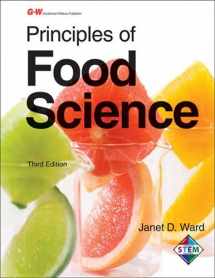
Principles of Food Science
Book details
Summary
Description
Principles of Food Science incorporates science concepts into a lab-oriented foods class. This text shows how the laws of science are at work in foods prepared at home and by the food industry. Each chapter includes engaging features, including NEW Going Green environmental updates and Science Matters articles. Other features focus on areas such as current research, technology, and nutrition news. Through lab experiments in the text and Lab Manual, students will practice scientific and sensory evaluation of foods. They will discover how nutrients and other food components illustrate basic chemistry concepts. Additionally, they will examine the positive and negative impacts of microorganisms on the food supply. Students will also explore the variety of careers available to graduates with a food science background.
• Students learn the scientific method and how to evaluate scientific studies. The text covers basic chemistry including the basic structure of atoms, the different types and forms of energy in the universe, measuring pH, and water’s role as a solvent.
• Physical properties, functions, and nutritional impact of the macronutrients are covered in the text.
• Students will learn about the micronutrients as well as other microcomponents including phytochemicals, food analogs, and additives.
• The positive and negative effects that microbes have on foods are explored.
• Various methods of food preservation and packaging are discussed as well as the benefits and drawbacks.
Special features throughout the text cover environmental issues, science facts, nutrition news, food science history, technology, recent research, international issues, and more.
Experiments at the end of each chapter and in the lab manual include safety tips and lists of needed equipment and supplies. Students employ the scientific method to perform the experiments.


We would LOVE it if you could help us and other readers by reviewing the book
Book review



